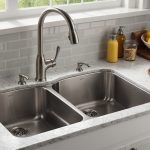Understanding Kitchen Timers
Kitchen timers can be an invaluable tool in any culinary environment, helping to improve kitchen efficiency and ensuring precision in meal preparation. Different kitchen timer types include digital, mechanical, and smart timers. Digital timers often feature LCD displays that are easy to read, while mechanical timers evoke a more traditional feel, often using a dial system and ticking sounds. Smart timers, on the other hand, can integrate with smartphones or home assistants, offering high-tech features for gadget lovers.
User-friendly timers are crucial for anyone looking to streamline their cooking process. Kitchen timers should be intuitive, with clear instructions and straightforward controls, minimizing the risk of user error. The importance of user-friendliness cannot be overstated as it enables users to focus more on cooking creativity than on operating a complex timer.
In the same genre : Discover the Top Kitchen Sink Materials: Durable and Easy-to-Clean Options Unveiled
In terms of kitchen efficiency, kitchen timers significantly impact meal preparation, allowing cooks to meticulously control cooking times. Proper timing is not only about avoiding overcooking or undercooking but also about coordinating various components of a meal to be ready simultaneously. By integrating different kitchen timer types, one can enhance culinary expertise and aid in creating flawless meals.
Key Features to Consider
When selecting a kitchen timer, understanding essential timer features can significantly influence your culinary adventures. Among these features, consider the alarm volume, ensuring it is loud enough to be heard over kitchen noises yet not startling. The display size is another crucial aspect; larger displays tend to be more accessible and user-friendly for a broad range of users.
In the same genre : How to Select the Ideal Ice Machine for Your Home Bar: An In-Depth Guide
Ease of setting a timer plays a pivotal role in usability. Simple interfaces that require minimal steps to set or reset help streamline cooking processes, reducing usability concerns and allowing more focus on the culinary task at hand.
Precision and accuracy are indispensable, especially in baking, where the timing is a precise science. A timer that provides minute accuracy can be the difference between a perfectly risen souffle and a culinary mishap.
Ultimately, usability impacts cooking outcomes and experiences, making it essential for timer features to align with user needs. A well-chosen kitchen timer can transform routine meal preparation into a seamless and efficient task, enhancing both cooking precision and overall kitchen efficiency. With these considerations in mind, you can ensure a smoother, more enjoyable cooking endeavour.
Comparing Popular Kitchen Timers
Evaluating kitchen timer reviews allows individuals to choose from an extensive range, each offering specific features to accommodate various culinary needs. Understanding product comparisons is essential in determining which timers suit your kitchen best.
Digital vs. Mechanical Timers
Digital timers often stand out for their ease of use with clear LCD displays and precise countdown features. They are ideal for those desiring straightforward controls and quick functionality. Mechanical timers, in contrast, appeal to users favouring simplicity and the nostalgic feel of winding a dial. These often come with audible ticking sounds and are valued for their battery-free operation. When considering precision, digital models typically offer finer minute and second adjustments, crucial for baking and time-sensitive recipes.
Smart Timers with App Integration
Exploring smart timers reveals advanced options integrating with phone apps for remote control and notifications. These timers offer versatility and enhanced kitchen efficiency, enabling individuals to multitask without losing track of cooking times. They cater to tech-savvy cooks looking for robust and feature-rich solutions.
Budget-Friendly Options
Cost-effective top kitchen timers encompass both basic digital and mechanical models. Despite a lower price point, many still deliver satisfactory performance, making them perfect for beginners or casual chefs diving into meal preparations without hefty investments.
Integrating Timers into Your Cooking Routine
Integrating kitchen timers efficiently can transform meal preparation from hectic to harmonious. Timer usage is not just about setting a countdown; it’s about strategically coordinating cooking steps. For instance, if you’re preparing a multi-course meal, it’s helpful to set separate timers for each dish. By doing so, you ensure that each element is cooked to perfection without fear of overlap or overcooking. This cooking tip can alleviate stress and improve dish quality.
Consider using different timer types for varying needs. A digital timer might be ideal for dishes requiring precise timing, whereas a mechanical timer can serve well for simpler tasks like boiling eggs. For the technologically inclined, smart timers offer the flexibility to sync with smartphones, ideal when managing complex meals that involve multitasking.
Incorporating timers effectively also hinges on thoughtful meal preparation. A succinct game plan, alongside timer integration, elevates cooking precision. Think about preparing ingredients and setting up your cooking environment before starting the timer. This approach not only divides your culinary tasks into manageable steps but ensures optimal use of the user-friendly timers, maximizing kitchen efficiency and confidence in achieving delightful meal outcomes.
User Experiences and Recommendations
User reviews provide invaluable insights into the performance and reliability of various kitchen timers. Many users appreciate digital timers for their clarity and precision, noting their ease of use and helpful countdown features. Conversely, mechanical timers often appeal for their simplicity and nostalgic charm, although some users point out they can be less accurate than digital types.
Customer feedback highlights the importance of user-friendly timers, particularly for individuals who value straightforward functionality during busy cooking sessions. For those juggling multiple meals, smart timers are frequently praised for their app-integration capabilities, allowing effortless time management and enhanced kitchen efficiency.
Recommendations based on cooking needs and preferences vary. Beginners and casual cooks might find digital timers sufficient, addressing basic needs without overwhelming complexity. However, more tech-savvy cooks may opt for smart timers, relishing in their versatility and additional features. Mechanical timers serve well for traditionalists, offering a tactile and nostalgic experience.
Focusing on these user experiences can guide you when choosing a kitchen timer that matches your needs, ensuring a tool that supports both routine and intricate culinary tasks effectively. By understanding varied perspectives, you make informed decisions that enhance your overall cooking adventures.
Visual Aids for Timer Comparison
Visual aids like kitchen timer charts offer a clearer understanding of different timers. This tool creates a broader perspective on the specifications and potential of each product. With features systematically listed, users can easily identify what’s most important to them, such as alarm volume, precision, or usability. Utilizing charts simplifies the selection process and assists in finding the most suitable option for individual needs.
Feature Comparison Chart
A well-organized chart effectively contrasts key timer features such as accuracy and ease of use. By providing a side-by-side comparison, users can view differences among models like digital, mechanical, and smart timers at a glance. It is an indispensable tool for decision-makers seeking comprehensive insights into their kitchen timer types.
Usage Scenarios Visualization
Visualizing timer usage in different cooking scenarios can greatly enhance kitchen efficiency. A diagram displaying use-cases offers concrete examples of how each timer can streamline meal preparation. This visual logic supports users in maximising their timers’ potential delivering on the promise of stress-free cooking adventures. Understanding these applications helps the consumer make an informed choice, ensuring a user-friendly and efficient addition to their culinary tools.











